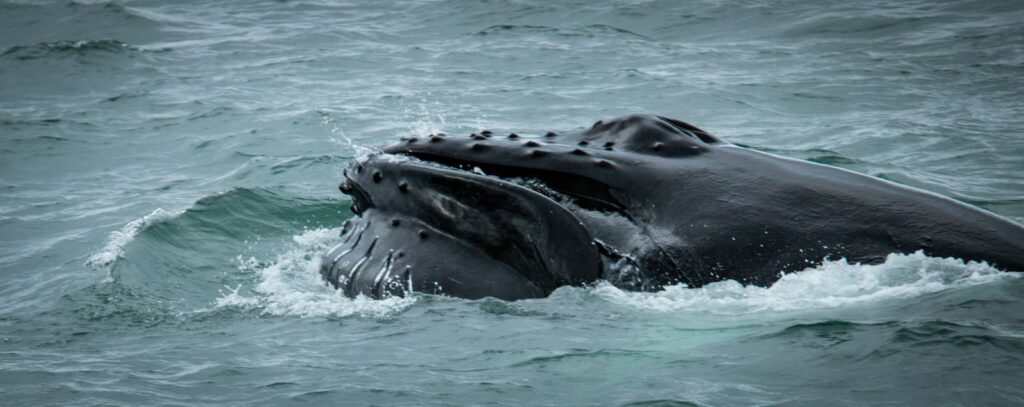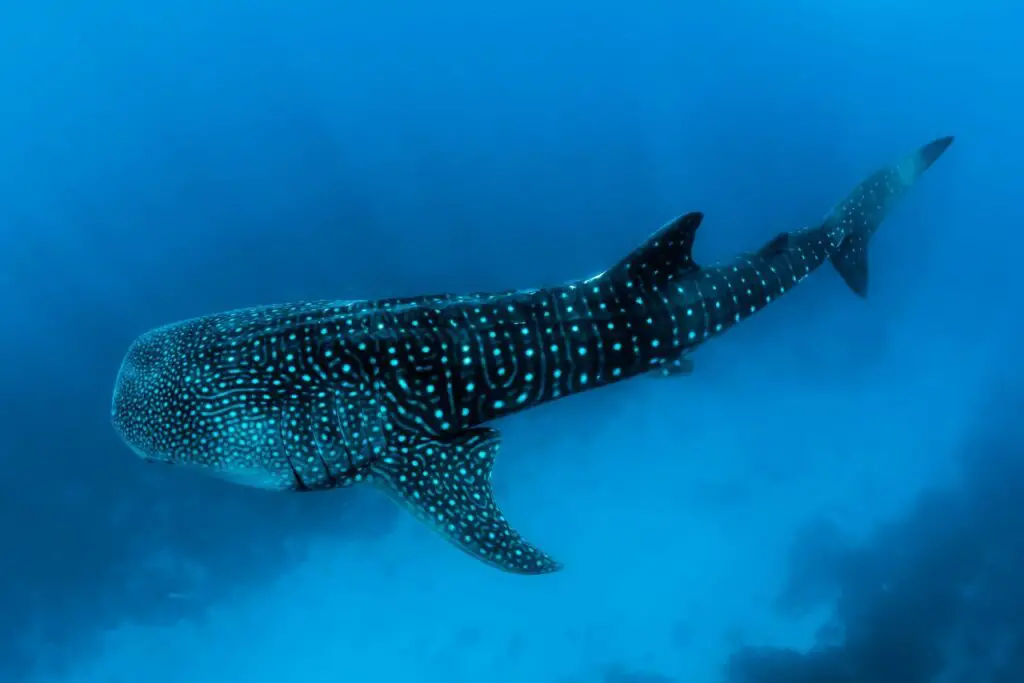While toothed whales, including orcas and belugas, are equipped with teeth for grasping and tearing prey, baleen, such as humpbacks and blue whales, utilize a completely different mechanism—baleen plates—to sieve minute food particles from the ocean.
This distinction shows the different feeding strategies among different whale species and highlights a fascinating area of evolutionary biology. These differences also show that such adaptations have enabled whales to thrive in diverse aquatic environments around the globe.
Key Takeaways:
- Toothed whales, such as sperm whales and dolphins, have a specific number of robust teeth for capturing and consuming prey.
- Baleen whales lack teeth and instead have baleen plates for filter feeding.
- Toothed whales (odontocetes) use teeth to grasp and tear prey, while Baleen whales use baleen plates to filter small food particles from water.
- Early whales had teeth for chewing, but some species evolved tooth loss and developed baleen plates for more efficient feeding strategies.
- Beyond feeding, teeth in toothed whales are used for sensory purposes, social interactions, and mating rituals.
- Unlike other mammals, whales have only one set of teeth throughout their lifetime. Baleen whales exhibit embryonic tooth buds, indicating evolutionary links to toothed ancestors.

Types of Whale Dentition
Whale dentition varies greatly among species, particularly between odontocetes, which possess teeth for capturing and consuming prey. Toothed whales, including species like dolphins and sperm whales, are equipped with a definitive number of teeth, essential for feeding and a range of other functions.
For instance, sperm whales have between 40 and 52 teeth and use them to grasp food in the deep sea. The structure of these teeth, comprising dentin, cement, and enamel, is robust and designed to withstand the pressures of deep-sea hunting and the demands of their aquatic environment.
In contrast, baleen whales do not have teeth. Instead, they have developed baleen plates that serve as a filtration system, supporting their unique filter-feeding method. These plates allow them to strain massive amounts of water to capture small fish and krill.
Teeth in toothed whales often serve beyond eating tools; they function as sensory organs. They use them for social interactions and mating rituals, indicating a complex use of teeth.
Evolution of Whale Teeth
Initially, early whales relied on their teeth to chew and process food, a method suited to their ecological roles and available prey. As evolutionary pressures mounted, tooth loss in whales emerged as a modification, signalling a shift towards more efficient feeding strategies in response to environmental changes.
This transformation was not merely about losing teeth but the evolution towards a baleen system. This sieve-like structure allowed whales to filter small aquatic organisms from seawater. This modification was important in diversifying whale species, enabling them to exploit new ecological niches and thrive in various marine environments.
Tooth loss and the development of baleen were significant because they demonstrated whales’ remarkable ability to undergo feeding adaptations. These changes show the dynamic nature of evolution, where survival hinges on combating adversities and turning environmental challenges into evolutionary opportunities.

Baleen Vs. Toothed Whales
Despite their shared lineage, baleen and toothed whales exhibit differences in their feeding mechanisms, primarily due to baleen plates in some and teeth in others. Whereas toothed whales have teeth designed for grasping and tearing prey, baleen whales are distinct in their adaptation to filter feeding. This adaptation involves the loss of teeth, replaced by baleen plates made of keratin, the same material found in human hair and nails.
Toothed Whales
Toothed whales, equipped with teeth, actively hunt and capture individual prey such as fish, squid, and crabs. The presence of teeth allows these whales to grasp, tear, and swallow their prey whole. This direct feeding method involves chasing and capturing live prey, which requires acute sensory capabilities.
Toothed whale species include well-known groups such as sperm whales, dolphins, and porpoises. These marine mammals are distinct from their baleen relatives due to their ability to echolocate, a critical adaptation for moving and hunting in the ocean’s murky depths. Using echolocation, toothed whales emit sound waves that bounce off objects, allowing them to pinpoint the location and size of prey.
Toothed whales, comprising about 70-73 species, are equipped with specialized teeth for seizing and holding slippery prey such as fish, squid, and crustaceans. Unlike baleen whales, which filter feed, these predators actively hunt and capture food using their sharp, conical teeth. The number and type of teeth vary significantly among species. For example, sperm whales possess 40-52 large, conical teeth primarily for grasping large squids deep in the ocean.
Baleen Whales
Baleen whales lack teeth but have baleen plates that serve as a filter-feeding system. These whales consume food by taking in large volumes of water rich in plankton, small fishes, and crustaceans. They then expel the water, trapping the food particles against the baleen plates. This filter-feeding mechanism efficiently processes large amounts of small prey and is critical in sustaining the massive body size of baleen whales.
There are 4 groups of baleen species, each characterized by two blowholes on its head. Baleen whales include the humpback, fin, minke, and blue whale. The plates’ shape, size and colour are different from one baleen species to another.
Baleen whale species, ranging from the massive blue whale to the smaller minke, have evolved to exploit different ecological niches compared to their toothed relatives, all due to the presence or absence of teeth and the adaptation to their respective feeding mechanisms.

Dental Development in Whales
Whales exhibit a unique dental development, characterized by having only one set of teeth throughout their lifetime. Unlike many mammals that undergo a change from milk teeth to permanent teeth, whales are born with the only set of teeth they will ever have.
In the embryonic stages of baleen whales, tooth buds are present, which suggests an evolutionary connection to their toothed ancestors. These tooth buds do not develop into functional teeth but indicate the historical shift from toothed to toothless whales.
Human Impact on Whale Feeding
Human activities have impacted the feeding behaviour and health of both baleen and toothed whales, with consequences ranging from physical damage to alterations in feeding behaviours.
Historically, the commercial hunting of whales for their teeth, blubber, and baleen has directly affected their populations. Today, whales with teeth face significant threats due to human impact. Pollution and habitat destruction jeopardize their health and feeding behaviour by contaminating their environment and food sources.
Toothed whales are particularly vulnerable to overfishing of their prey species, which can lead to changes in diet and subsequently affect their health. The pervasive use of sonar and other noise pollution disrupts these whales’ echolocation abilities, which are important for effective hunting and maintaining health.
Conservation efforts play a pivotal role in addressing these challenges. Protecting the habitats of toothed whales and regulating fishing practices to promote sustainable prey populations are important steps. Furthermore, reducing noise pollution and implementing stricter pollution regulations can help safeguard whales’ feeding resources and health.
Conclusions
The differences between toothed and baleen whales highlight these animals’ diverse strategies to exploit various ecological niches.
Toothed whales, equipped with robust teeth, are adept at actively hunting and capturing prey. In contrast, baleen whales have evolved sophisticated filter-feeding systems that allow them to process vast amounts of small aquatic organisms efficiently.
The evolutionary transition from teeth to baleen plates in some whale species shows the dynamic nature of adaptation, driven by environmental pressures and opportunities. This shift signifies a remarkable transformation in feeding strategies and the broader principle of how species can diversify and thrive in response to changing conditions.
Human activities have historically impacted whale populations through hunting and continue to pose significant threats through pollution, habitat destruction, and overfishing.



